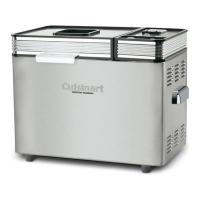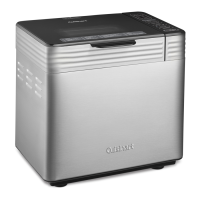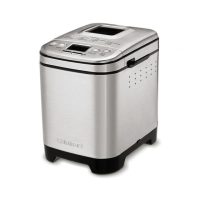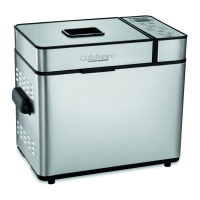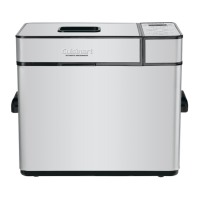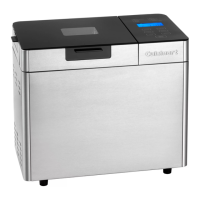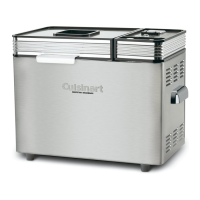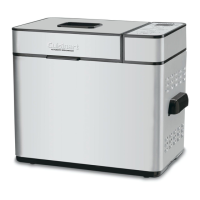15
allow the yeast to touch the wet ingredients. See detailed instructions
on page 13.
Temperature of ingredients is important in bread machine baking.
Ideal temperatures are between 75°–90°F (24°–32°C). Use an instant-
read thermometer to check the temperatures. Cold ingredients should
be allowed to come to room temperature. Liquids and butter may be
combined and placed in a microwave on the defrost setting to warm
without heating too hot.
When adapting a recipe, do not omit the little amounts of ½ teaspoon
(2 ml) or less – they are essential to the chemical composition of the
bread.
Vital wheat gluten can be added to recipes to improve loaf height,
texture and structure – particularly with whole grain ours, or breads
using whole wheat, oat our or rye ours. It also aids in rising when
using the Rapid Rise cycles, and is essential to the Last-Minute
Loaves.
It is especially important to keep yeast separate from salt if using
Delay Start Timer feature – add salt with the liquids and the yeast last
on top of the our. See page 13.
Nuts and seeds, raisins and dried fruits, shredded cheeses, chocolate
morsels, and any other additions to the dough should be added when
the Mix-in signal sounds except for Low Carb, Quick Bread, Gluten
Free, and Last Minute Loaf programs.
For a more uniform loaf of bread, remove the dough when you hear
the remove paddle signal, then remove the kneading paddle and
reshape the dough into a neat loaf. This will ensure a more uniformly
shaped loaf of bread, particularly with the smaller 1 and 1 ½-pound
loaves.
Use the Whole Wheat program when baking breads containing not
only whole wheat our, but other heavy ours that will require a longer
knead and rise – an example of this would be pumpernickel bread.
All breads slice best when allowed to cool for a minimum of 30
minutes (preferably longer) before slicing. If you wish to serve bread
warm, wrap in foil and heat in oven. (However, we recommend serving
a Last-Minute Loaf warm).
For quick breads/batter breads, spray the bottom and halfway up the
sides of the bread pan with cooking spray before adding ingredients,
to assist in release. Loosen the loaf with a plastic spatula before turn-
ing out.
Amounts/Sizes/Ingredients
For white breads and any recipe calling for a white our (unless it is a
quick/batter bread requiring cake our), the best our to use is bread
our, which has a higher protein content.
A general formula for a 1½-pound bread machine loaf is: 3 cups (750
ml) bread our, 1
1
⁄8 – 1¼ cups (280 – 300 ml) liquid, 1 teaspoon (5 ml)
salt, 1 teaspoon (5 ml) sugar, 1¾ – 2 teaspoons (8 – 10 ml) yeast. Use
this as your basic formula and make adjustments from there.
In general, a 2-cup (500 ml) our recipe will produce a loaf that is
about 1 pound (454 g) , a 3-cup (750 ml) our recipe will produce a
loaf that is about 1½ pounds (680 g), and a 4-cup (1 L) our recipe
will produce a loaf that is about 2 pounds (908 ml). Some recipes will
have slightly larger or smaller amounts of our for each size, and with
Mix-ins, they may weigh more than 1 pound (454 g), 1½ pounds (680 g)
or 2 pounds (908 g).
You should not use more than 5 cups (1.25 L) our total in the bread
machine.
If you are adapting a recipe, and your mathematical measurements
become something odd such as half of an egg, use a small egg as a
replacement for half. A large egg is generally equal to about ¼ cup (50 ml).
It is important to measure ingredients accurately – do not be tempted
to omit small amounts such as
1
⁄8 teaspoon (0.5 ml). Baking is chem-
istry, and changing the formula by even this small amount can change
the nal product signicantly.
A pinch of ginger or a bit of vitamin C can give a boost to the yeast
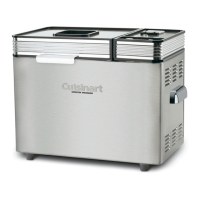
